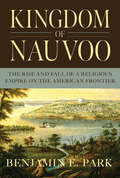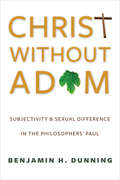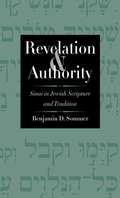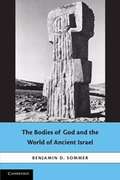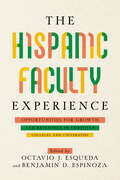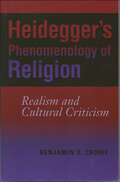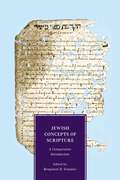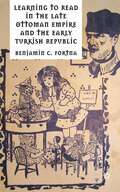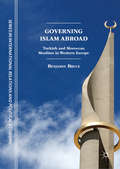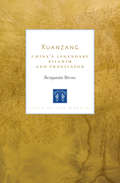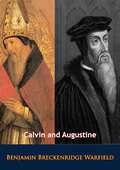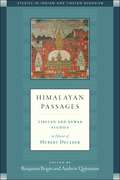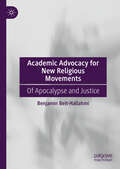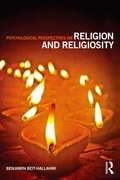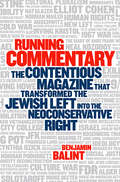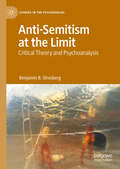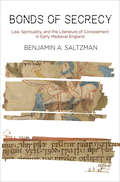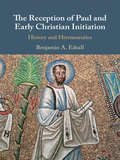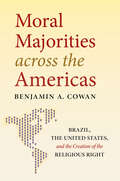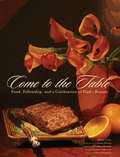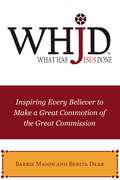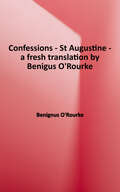- Table View
- List View
Kingdom of Nauvoo: The Rise And Fall Of A Religious Empire On The American Frontier
by Benjamin E. ParkAn extraordinary story of faith and violence in nineteenth-century America, based on previously confidential documents from the Church of Jesus Christ of Latter-day Saints. Compared to the Puritans, Mormons have rarely gotten their due, treated as fringe cultists at best or marginalized as polygamists unworthy of serious examination at worst. In Kingdom of Nauvoo, the historian Benjamin E. Park excavates the brief life of a lost Mormon city, and in the process demonstrates that the Mormons are, in fact, essential to understanding American history writ large. Drawing on newly available sources from the LDS Church—sources that had been kept unseen in Church archives for 150 years—Park recreates one of the most dramatic episodes of the 19th century frontier. Founded in Western Illinois in 1839 by the Mormon prophet Joseph Smith and his followers, Nauvoo initially served as a haven from mob attacks the Mormons had endured in neighboring Missouri, where, in one incident, seventeen men, women, and children were massacred, and where the governor declared that all Mormons should be exterminated. In the relative safety of Nauvoo, situated on a hill and protected on three sides by the Mississippi River, the industrious Mormons quickly built a religious empire; at its peak, the city surpassed Chicago in population, with more than 12,000 inhabitants. The Mormons founded their own army, with Smith as its general; established their own courts; and went so far as to write their own constitution, in which they declared that there could be no separation of church and state, and that the world was to be ruled by Mormon priests. This experiment in religious utopia, however, began to unravel when gentiles in the countryside around Nauvoo heard rumors of a new Mormon marital practice. More than any previous work, Kingdom of Nauvoo pieces together the haphazard and surprising emergence of Mormon polygamy, and reveals that most Mormons were not participants themselves, though they too heard the rumors, which said that Joseph Smith and other married Church officials had been “sealed” to multiple women. Evidence of polygamy soon became undeniable, and non-Mormons reacted with horror, as did many Mormons—including Joseph Smith’s first wife, Emma Smith, a strong-willed woman who resisted the strictures of her deeply patriarchal community and attempted to save her Church, and family, even when it meant opposing her husband and prophet. A raucous, violent, character-driven story, Kingdom of Nauvoo raises many of the central questions of American history, and even serves as a parable for the American present. How far does religious freedom extend? Can religious and other minority groups survive in a democracy where the majority dictates the law of the land? The Mormons of Nauvoo, who initially believed in the promise of American democracy, would become its strongest critics. Throughout his absorbing chronicle, Park shows the many ways in which the Mormons were representative of their era, and in doing so elevates nineteenth century Mormon history into the American mainstream.
Prophets and Protons: New Religious Movements and Science in Late Twentieth-Century America (New and Alternative Religions #4)
by Benjamin E ZellerThis in-depth study shows how new religious movements offer a variety of strategies for reconciling science and religious faith. By the twentieth century, established religious traditions were forced to grappled with the challenges presented by scientific knowledge and innovation. But emerging religions, still led by a living founder to guide them, found news ways to respond to science. The Hare Krishnas, the Unification Church, and Heaven&’s Gate each found distinct ways to incorporate major findings of modern American science, understanding it as central to their wider theological and social agendas. In Prophets and Photons, Benjamin Zeller examines how these New Religious Movements (NRMs) crafted their views on science during their founding period, and how those views evolved over time. These NRMs shed light on how religious groups—new, old, alternative, or mainstream—could respond to the tremendous growth of power and prestige of science in late twentieth-century America. In this engrossing book, Zeller carefully shows that religious groups had several methods of creatively responding to science, and that the often-assumed conflict-based model of &“science vs. religion&” must be replaced by a more nuanced understanding of how religions operate in our modern scientific world.
Christ Without Adam: Subjectivity and Sexual Difference in the Philosophers' Paul (Gender, Theory, and Religion)
by Benjamin DunningThe apostle Paul deals extensively with gender, embodiment, and desire in his authentic letters, yet many of the contemporary philosophers interested in his work downplay these aspects of his thought. Christ Without Adam is the first book to examine the role of gender and sexuality in the turn to the apostle Paul in recent Continental philosophy. It builds a constructive proposal for embodied Christian theological anthropology in conversation with—and in contrast to—the "Paulinisms" of Stanislas Breton, Alain Badiou, and Slavoj i ek.Paul's letters bequeathed a crucial anthropological aporia to the history of Christian thought, insofar as the apostle sought to situate embodied human beings typologically with reference to Adam and Christ, but failed to work out the place of sexual difference within this classification. As a result, the space between Adam and Christ has functioned historically as a conceptual and temporal interval in which Christian anthropology poses and re-poses theological dilemmas of embodied difference. This study follows the ways in which the appropriations of Paul by Breton, Badiou, and i ek have either sidestepped or collapsed this interval, a crucial component in their articulations of a universal Pauline subject. As a result, sexual difference fails to materialize in their readings as a problem with any explicit force. Against these readings, Dunning asserts the importance of the Pauline Adam–Christ typology, not as a straightforward resource but as a witness to a certain necessary failure—the failure of the Christian tradition to resolve embodied difference without remainder. This failure, he argues, is constructive in that it reveals the instability of sexual difference, both masculine and feminine, within an anthropological paradigm that claims to be universal yet is still predicated on male bodies.
Revelation and Authority
by Benjamin D. SommerAt once a study of biblical theology and modern Jewish thought, this volume describes a "participatory theory of revelation" as it addresses the ways biblical authors and contemporary theologians alike understand the process of revelation and hence the authority of the law. Benjamin Sommer maintains that the Pentateuch's authors intend not only to convey God's will but to express Israel's interpretation of and response to that divine will. Thus Sommer's close readings of biblical texts bolster liberal theologies of modern Judaism, especially those of Abraham Joshua Heschel and Franz Rosenzweig. This bold view of revelation puts a premium on human agency and attests to the grandeur of a God who accomplishes a providential task through the free will of the human subjects under divine authority. Yet, even though the Pentateuch's authors hold diverse views of revelation, all of them regard the binding authority of the law as sacrosanct. Sommer's book demonstrates why a law-observant religious Jew can be open to discoveries about the Bible that seem nontraditional or even antireligious.
The Bodies of God and the World of Ancient Israel
by Benjamin D. SommerIn The Bodies of God and the World of Ancient Israel, Benjamin D. Sommer investigates the notion of a deity's body and self in ancient Israel, Canaan, and Mesopotamia. He uncovers a lost ancient Near Eastern perception of divinity according to which an essential difference between gods and humans was that gods had more than one body and fluid, unbounded selves. Though the dominant strains of biblical religion rejected it, a monotheistic version of this theological intuition is found in some biblical texts. Later Jewish and Christian thinkers inherited this ancient way of thinking; ideas such as the sefirot in kabbalah and the trinity in Christianity represent a late version of this theology. This book forces us to rethink the distinction between monotheism and polytheism, as this notion of divine fluidity is found in both polytheistic cultures (Babylonia, Assyria, Canaan) and monotheistic ones (biblical religion, Jewish mysticism, Christianity), whereas it is absent in some polytheistic cultures (classical Greece). The Bodies of God and the World of Ancient Israel has important repercussions not only for biblical scholarship and comparative religion but for Jewish-Christian dialogue.
The Hispanic Faculty Experience: Opportunities for Growth and Retention in Christian Colleges and Universities
by Benjamin D. EspinozaHispanics are not a current trend. They have been here for centuries and embody an integral part of the United States and higher education. Every racial term—including Hispanic, Latino/a, and more recently Latinx and Latine—is imperfect and problematic. There is no consensus about what works best. Despite this reality, the lives and stories of non-White faculty are essential to the future of Christian higher education. Each author shares their account of working in a predominately White Christian institution. Filled with triumphs, struggles, and penetrating insights, the chapters explain what it is like to experience the shifting demographics of today’s universities, which are bringing increasing numbers of Hispanic students even as the overall number of Hispanic colleagues remains exceedingly small. This book will be especially useful for leaders who may be unaware of how difficult it is to navigate the challenges of Christian higher education as Hispanic faculty.
Heidegger's Phenomenology of Religion: Realism and Cultural Criticism (Philosophy of Religion)
by Benjamin D. CroweThroughout his long and controversial career, Martin Heidegger developed a substantial contribution to the phenomenology of religion. In Heidegger's Phenomenology of Religion, Benjamin D. Crowe examines the key concepts and developmental phases that characterized Heidegger's work. Crowe shows that Heidegger's account of the meaning and structure of religious life belongs to his larger project of exposing and criticizing the fundamental assumptions of late modern culture. He reveals Heidegger as a realist through careful readings of his views on religious attitudes and activities. Crowe challenges interpretations of Heidegger's early efforts in the phenomenology of religion and later writings on religion, including discussions of Greek religion and Hölderlin's poetry. This book is sure to spark discussion and debate as Heidegger's work in religion and the philosophy of religion becomes increasingly important to scholars and beyond.
Jewish Concepts of Scripture: A Comparative Introduction
by Benjamin D SommerWhat do Jews think scripture is? How do the People of the Book conceive of the Book of Books? In what ways is it authoritative? Who has the right to interpret it? Is it divinely or humanly written? And have Jews always thought about the Bible in the same way? In seventeen cohesive and rigorously researched essays, this volume traces the way some of the most important Jewish thinkers throughout history have addressed these questions from the rabbinic era through the medieval Islamic world to modern Jewish scholarship. They address why different Jewish thinkers, writers, and communities have turned to the Bible—and what they expect to get from it. Ultimately, argues editor Benjamin D. Sommer, in understanding the ways Jews construct scripture, we begin to understand the ways Jews construct themselves.
An Introduction to Design Arguments
by Benjamin C. JantzenThe history of design arguments stretches back to before Aquinas, who claimed that things which lack intelligence nevertheless act for an end to achieve the best result. Although science has advanced to discredit this claim, it remains true that many biological systems display remarkable adaptations of means to ends. Versions of design arguments have persisted over the centuries and have culminated in theories that propose an intelligent designer of the universe. This volume is the only comprehensive survey of 2,000 years of debate, drawing on both historical and modern literature to identify, clarify, and assess critically the many forms of design argument for the existence of God. It provides a neutral, informative account of the topic from antiquity to Darwin, and includes concise primers on probability and cosmology. It will be of great value to upper-level undergraduates and graduates in philosophy of religion, theology, and philosophy of science.
Learning to Read in the Late Ottoman Empire and the Early Turkish Republic
by Benjamin C. FortnaAn exploration of the ways in which children learned and were taught to read, against the background of the transition from Ottoman Empire to Turkish Republic. This study gives us a fresh perspective on the transition from empire to republic by showing us the ways that reading was central to the construction of modernity.
Governing Islam Abroad: Turkish And Moroccan Muslims In Western Europe (The\sciences Po Series In International Relations And Political Economy Ser.)
by Benjamin BruceFrom sending imams abroad to financing mosques and Islamic associations, home states play a key role in governing Islam in Western Europe. Drawing on over one hundred interviews and years of fieldwork, this book employs a comparative perspective that analyzes the foreign religious activities of the two home states with the largest diaspora populations in Europe: Turkey and Morocco. The research shows how these states use religion to promote ties with their citizens and their descendants abroad while also seeking to maintain control over the forms of Islam that develop within the diaspora. The author identifies and explains the internal and foreign political interests that have motivated state actors on both sides of the Mediterranean, ultimately arguing that interstate cooperation in religious affairs has and will continue to have a structural influence on the evolution of Islam in Western Europe.
Xuanzang: China’s Legendary Pilgrim and Translator
by Benjamin BroseThe life and legacy of Xuanzang: a Buddhist seeker, philosopher, and intrepid traveler who became the world's most famous pilgrim.In the fall of 629, Xuanzang (600–662), a twenty-nine-year-old Buddhist monk, left the capital of China to begin an epic pilgrimage across the country, through the deserts of Central Asia, and into India. His goal was to locate and study authentic Buddhist doctrine and practice, then bring the true teachings back to his homeland. Over the course of nearly seventeen years, he walked thousands of miles and visited hundreds of Buddhist monasteries and monuments. He studied with the leading teachers of his day and compiled a written account of his travels that remains a priceless record of premodern Indian history, religion, and culture. When Xuanzang finally returned to China in 645, he brought with him a treasure trove of new texts, relics, and icons. This transmission of Indian Buddhist teachings to China, made possible by Xuanzang&’s unparalleled vision and erudition, was a landmark moment in the history of East Asian Buddhism. As with many great pre-modern religious figures, the legends surrounding Xuanzang&’s life have taken on lives of their own. His story has been retold, reshaped, and repurposed by generations of monastics and laypeople. In this comprehensive and engaging account, Benjamin Brose charts a course between the earliest, most reliable accounts of Xuanzang&’s biography and the fantastic legends that later developed, such as those in the classic Chinese novel Journey to the West. Xuanzang remains one of the most consequential monks in the rich history of Buddhism in East Asia. This book is an indispensable introduction to his extraordinary life and enduring legacies.
Calvin and Augustine
by Benjamin Breckenridge WarfieldAs the Christian Church views the panorama of her history, two figures stand out in bold relief. They are Augustine and Calvin. Their influence has shaped the religious life and theological thought for centuries. For a thousand years since the fourth century the religious genius of Augustine determined the development of the Christian Church. And from the days of the Reformation to this present day it is the religious genius of Calvin, along with that of Luther, that has played such an important part in the Christian Church. To this day the “Institutes” of Calvin remains the “masterpiece of Protestant Theology.” These two extraordinarily gifted men tower like pyramids over the scene of history.To properly evaluate the work of Calvin and Augustine, requires unusual gifts. These are found in Benjamin Breckinridge Warfield. In the minds of not a few, Warfield is one of the outstanding theologians since Calvin. Because of his lucid and stately style of writing, his penetrating gift of analysis, his knowledge of the works of Calvin and Augustine, and his firm grasp of Reformed theology, there was no one better qualified to estimate and express the unique place of Calvin and Augustine in the history of the Christian Church. Christian literature has been enriched by the studies found in this book.
Himalayan Passages
by Andrew Quintman Benjamin BoginExplore new research on the religious and cultural traditions of the Himalayan Buddhist world.Over decades, hundreds of American undergraduates spending a semester abroad have been introduced to Tibetan culture in India, Nepal, and China by Hubert Decleer. A number went on to become prominent scholars in the field at institutions such as Yale, Berkeley, and Georgetown, and as a tribute to him they have put together this collection of cutting-edge research in Himalayan studies, bringing together contributions of this new generation with those of senior researchers in the field. This new research on the religion and culture of the Himalayan Buddhist world spans a broad range of subjects, periods, and approaches, and the diversity and strength of the contributions ensures Himalayan Passages be warmly welcomed by scholars, travelers, and Tibetan Buddhists alike. Highlights include: Donald S. Lopez, Jr. tells the story of Gendun Chopel's unusual visit to Sri Lanka in 1941. Leonard van der Kuijp examines the Bodhicittavivarana, an ancient work on the enlightened resolve to free all beings. Kabir Mansingh Heimsath compares Western and Chinese curatorial approaches to Tibetan modern art. Alexander von Rospatt illuminates the fascinating history and artistic details of the famous Svayambhu stupa in Kathmandu. Sarah H. Jacoby translates the short autobiography of Sera Khandro, the celebrated female Tibetan mystic of a century ago. Additional contributors include Franz-Karl Ehrhard, Ernst Steinkellner, Jacob P. Dalton, Iain Sinclair, Anne Vergati, Punya Prasad Parajuli, and Dominique Townsend.
Los secretos de la Capilla Sixtina
by Benjamin BlechPrepárese para desaprender todo lo que creía saber sobre la Capilla Sixtina y las obras maestras de Miguel ángel. Este libro procurará desplazar siglos de prejuicio, censura e ignorancia de uno de los tesoros del arte más famosos y queridos del mundo. Hace quinientos años Miguel ángel comenzó una pintura que se convirtió en una de las piezas de arte más famosas del mundo: el cielorraso de la Capilla Sixtina. Todos los años, millones de personas se acercan a ver el cielorraso Sixtino de Miguel ángel, el fresco más grande del mundo en la más sagrada de las capillas cristianas; sin embargo, no hay una sola imagen cristiana en esta vasta, magnífica obra de arte.
Academic Advocacy for New Religious Movements: Of Apocalypse and Justice
by Benjamin Beit-HallahmiThis book explores the intersection of advocacy and academic practice within the social sciences, focusing on the ethical dimensions and potential consequences of researchers engaging in political action on behalf of the groups they study. Investigating the ethical and practical implications of advocacy in academic work, specifically within the social sciences. It examines how scholars, guided by their research and vision for social change, engage politically to support the groups they study. The book addresses the debate surrounding academic advocacy: is it harmful or a necessary pursuit? Through a detailed study of a historical advocacy movement, it analyzes the global campaign to gain legitimacy for new religious movements (NRMs) between 1980 and 2000. It is an important read for scholars of New Religious Movements and those interested in the way religion is studied.
Psychological Perspectives on Religion and Religiosity
by Benjamin Beit-HallahmiIs religion to blame for deadly conflicts? Should religious behaviour be credited more often for acts of charity and altruism? In what ways are religious and ‘spiritual’ ideas, practices and identities surviving and changing as religion loses its political power in those parts of the world which are experiencing increasing secularization? Written by one of the world’s leading authorities on the psychology of religion and social identity, Psychological Perspectives on Religion and Religiosity offers a comprehensive and multidisciplinary review of a century of research into the origins and consequences of religious belief systems and religious behaviour. The book employs a unique theoretical framework that combines the ‘new’ cognitive-evolutionary psychology of religion, examining the origins of religious ideas, with the ‘old’ psychology of religiosity, which looks at correlates and consequences. It examines a wide range of psychological variables and their relationship with religiosity. It is also provides fresh insights into classical topics in the psychology of religion, such as religious conversion, the relevance of Freud’s ideas about religion and religiosity, the meaning of secularization, and the crucial role women play in religion. The book concludes with the author’s reflections on the future for the psychology of religion as a field. Psychological Perspectives on Religion and Religiosity will be invaluable for academic researchers in psychology, sociology, anthropology, political science, economics, and history worldwide. It will also be of great interest to advanced undergraduate students and graduate students across the social sciences.
Running Commentary: The Contentious Magazine that Transformed the Jewish Left into the Neoconservative Right
by Benjamin BalintIn the years of cultural and political ferment following World War II, a new generation of Jewish- American writers and thinkers arose to make an indelible mark on American culture. Commentary was their magazine; the place where they and other politically sympathetic intellectuals-Hannah Arendt, Saul Bellow, Lionel Trilling, Alfred Kazin, James Baldwin, Bernard Malamud, Philip Roth, Cynthia Ozick and many others-shared new work, explored ideas, and argued with each other. Founded by the offspring of immigrants, Commentary began life as a voice for the marginalized and a feisty advocate for civil rights and economic justice. But just as American culture moved in its direction, it began-inexplicably to some-to veer right, becoming the voice of neoconservativism and defender of the powerful. This lively history, based on unprecedented access to the magazine’s archives and dozens of original interviews, provocatively explains that shift while recreating the atmosphere of some of the most exciting decades in American intellectual life.
Anti-Semitism at the Limit: Critical Theory and Psychoanalysis (Studies in the Psychosocial)
by Benjamin B. StrosbergIn this book, Benjamin Strosberg explores difficulties and anxieties inherent in studying, defining, and defending against anti-Semitism by tracing a concurrent difficulty in thinking about Jewishness, which has historically served as a limit case for central social categories such as outsider, religion, race, gender, and nation. Dr. Strosberg draws on Zygmunt Bauman’s concept of proteophobia—the anxious fear of what doesn’t fit into clear-cut categories—to think more carefully about anti-Semitism as response to the complex-realities of ambivalence and otherness. The book proposes ‘negative psychology’ as a methodology for studying anti-Semitism and proteophobia rooted in psychoanalysis and Theodor Adorno’s Critical Theory. Drawing from lived experiences, contemporary events, and debates in the field, this compelling work explores the broad implications of the investigation of anti-Semitism for politics, education, and psychoanalysis, as well as the specific implications for Jewish identity and resistance.
Bonds of Secrecy: Law, Spirituality, and the Literature of Concealment in Early Medieval England (The Middle Ages Series)
by Benjamin A. SaltzmanWhat did it mean to keep a secret in early medieval England? It was a period during which the experience of secrecy was intensely bound to the belief that God knew all human secrets, yet the secrets of God remained unknowable to human beings. In Bonds of Secrecy, Benjamin A. Saltzman argues that this double-edged conception of secrecy and divinity profoundly affected the way believers acted and thought as subjects under the law, as the devout within monasteries, and as readers before books. One crucial way it did so was by forming an ethical relationship between the self and the world that was fundamentally different from its modern reflex. Whereas today the bearers of secrets might be judged for the consequences of their reticence or disclosure, Saltzman observes, in the early Middle Ages a person attempting to conceal a secret was judged for believing he or she could conceal it from God. In other words, to attempt to hide from God was to become ensnared in a serious sin, but to hide from the world while deliberately and humbly submitting to God's constant observation was often a hallmark of spiritual virtue.Looking to law codes and religious architecture, hagiographies and riddles, Bonds of Secrecy shows how legal and monastic institutions harnessed the pervasive and complex belief in God's omniscience to produce an intense culture of scrutiny and a radical ethics of secrecy founded on the individual's belief that nothing could be hidden from God. According to Saltzman, this ethics of secrecy not only informed early medieval notions of mental activity and ideas about the mind but also profoundly shaped the practices of literary interpretation in ways that can inform our own contemporary approaches to reading texts from the past.
The Reception of Paul and Early Christian Initiation: History and Hermeneutics
by Benjamin A. EdsallThis book breaks new ground in New Testament reception history by bringing together early Pauline interpretation and the study of early Christian institutions. Benjamin Edsall traces the close association between Paul and the catechumenate through important texts and readers from the late second century to the fourth century to show how the early Church arrived at a wide-spread image of Paul as the apostle of Christian initiation. While exploring what this image of Paul means for understanding early Christian interpretation, Edsall also examines the significance of this aspect of Pauline reception in relation to interpretive possibilities of Paul's letters. Building on the analysis of early interpretations and rhetorical images of the Apostle, Edsall brings these together with contemporary scholarly discourse. The juxtaposition highlights longstanding continuity and conflict in exegetical discussions and dominant Pauline images. Edsall concludes with broader hermeneutical reflections on the value of historical reception for New Testament Studies.
Moral Majorities across the Americas: Brazil, the United States, and the Creation of the Religious Right
by Benjamin A. CowanThis new history of the Christian right does not stop at national or religious boundaries. Benjamin A. Cowan chronicles the advent of a hemispheric religious movement whose current power and influence make headlines and generate no small amount of shock in Brazil and the United States. These two countries, Cowan argues, played host to the principal activists and institutions who collaboratively fashioned the ascendant religious conservatism of the late twentieth century. Cowan not only unearths the deep historical connections between Brazilian and U.S. religious conservatives but also proves just how essential Brazilian thinkers, activists, and institutions were to engendering right-wing political power in the Americas.Cowan shows that both Protestant and Catholic religious warriors began to commune in the 1930s around a passionate aversion to mainstream ecumenicalism and moderate political ideas. Brazilian intellectuals, politicians, religious leaders, and captains of industry worked with partners at home and in the United States to build a united right. Together, activists engaged in a series of reactionary theological discussions. Their transnational, transdenominational platform fostered a sense of common cause and allowed them to develop a series of strategies that pushed once marginal ideas to the center of public discourse, reshaped religious demographics, and effected a rightward shift in politics across two continents.
Come to the Table: Food, Fellowship, and a Celebration of God's Bounty (A\souledout Sisters Novel Ser.)
by Benita LongA cookbook with a focus on entertaining family and friends, featuring photographs of table settings and meals, as well inspirational quotes and Scriptures. God intends for us, as sacred life travelers, to celebrate and enjoy His bounty. Every man should eat and drink and enjoy the good of all his labor for it is the gift of God.This celebration of life was intended by God to be a way of life now and as preparation for a future event in which as followers of Christ, all are invited to participate. God intends for us to enjoy his blessings in abundance.Come to the Table is a threefold feast. For the mind, there are thought-provoking quotations from great poets and thinkers. For the spirit, stunning photographs and inspirational Scriptures transport you to another realm. For the body, there are hearty and delectable recipes.Inside the collection, you’ll find soothing dishes for the soul including . . . Parmesan Grits Casserole,Grilled Lemon Chicken,Cheddar Squash Strata,Lamb Kabobs and much more! Throughout Come to the Table, very few people appear. This is our personal way of inviting you to claim each setting as your own.“That the mountains shall drip with new wine, the hills shall flow with milk, and all the brooks of Judah shall be flooded with water” [Joel 3:18].
WHJD What Has Jesus Done: Inspiring Every Believer to Make a Great Commotion of the Great Commission
by Babbie Mason Benita DearWhen was the last time you actively shared the good news of how Jesus Christ changed the course of your life?Are you sometimes reluctant, consumed by judgment or even fearful to proclaim your love for Christ?Award-winning gospel singer and songwriter, Babbie Mason and instructional math coach and entrepreneur, Benita Dear, are sisters and pastor&’s daughters. They know personally when Jesus Christ changes your life for all eternity, it&’s a really big deal! In WHJD--What has Jesus Done, Babbie and Benita challenge believers to use their own personal testimony of faith as a catalyst to stand up for Christ, step up in faith and speak up about the amazing difference Jesus makes.In WHJD--What Has Jesus Done, you&’ll realize the great things God has done for you deserve to be celebrated each and every day. In a time where more Christians are sharing their faith less than ever before, Babbie and Benita motivate the community of believers to use their own God-story to make a great commotion of the Great Commission. In WHJD--What Has Jesus Done, you'll discover:God wants to spread His love for the world through youEvery Christian has a God-story to share – including youYour God-story is important, beautiful and as unique as youSharing your God-story makes a big difference empowering youSharing Christ with others is much easier than you thinkYou can fearlessly share your faith through acts of kindnessIn WHJD--What Has Jesus Done, you&’ll find that sharing your faith is not an old-fashioned practice for pastors and evangelists but a daily privilege for every Christian. On each page, you&’ll gain confidence and encouragement to shine your light for Christ no matter where you are in your faith walk. Discover how to put your faith into action to effectively tell your God-story, impact others for Christ, overcome life&’s challenges, strengthen relationships, deepen personal worship, integrate faith and culture and much more. Changing the world for Christ starts with you. WHJD--What Has Jesus Done can show you how.
Confessions: St Augustine
by Benignus O'RourkeA canticle to God, and full of psychological insights that might have been written yesterday, the Confessions are the story of a soul, the story of God, and how he is constantly at work seeking us.’ Confessions is perhaps the most important spiritual autobiography of all: it chronicles Saint Augustine’s wild, dissonant youth and subsequent conversion to Christianity, as well as providing significant divine and philosophical insight. Bestselling author, Fr Benignus O’Rourke OSA, provides a new and luminescent translation of Confessions, his beautiful and eloquent prose shedding new light on the various shades of meaning in Saint Augustine’s meditations and stories. Each book is prefaced with an introduction providing further accessibility and depth of understanding of this seminal work.
